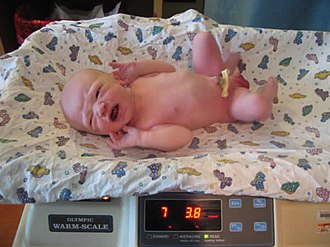Handle position
The handle position is a posture of the arms that is physiologically adopted by newborns . It is due to the fact that in all newborns the tension ( tone ) of the flexor muscles is higher than that of the extensors. Therefore, the shoulders are pulled up, resulting in a shortened shoulder-neck line. The upper arm is pulled relatively strongly to the chest ( adduction in the shoulder). The arms are bent ( flexed ) in the elbow joints up to the soft tissue barrier . The hands are turned inward ( pronation ) and flexed at the wrists. Typically there is also a fist closure.
The position of the handle can be observed in the supine position as well as in the prone position and is normally lost by the second month of life. If it persists beyond that, this can be an indication of the presence of infantile cerebral palsy with development of spastic paralysis. Affected children then later get shortening of the ligaments and tendons of the joints involved ( contractures ). The simplest everyday activities, such as eating, are then significantly more difficult. In such a case, treatment consists of early physiotherapy or occupational therapy .
